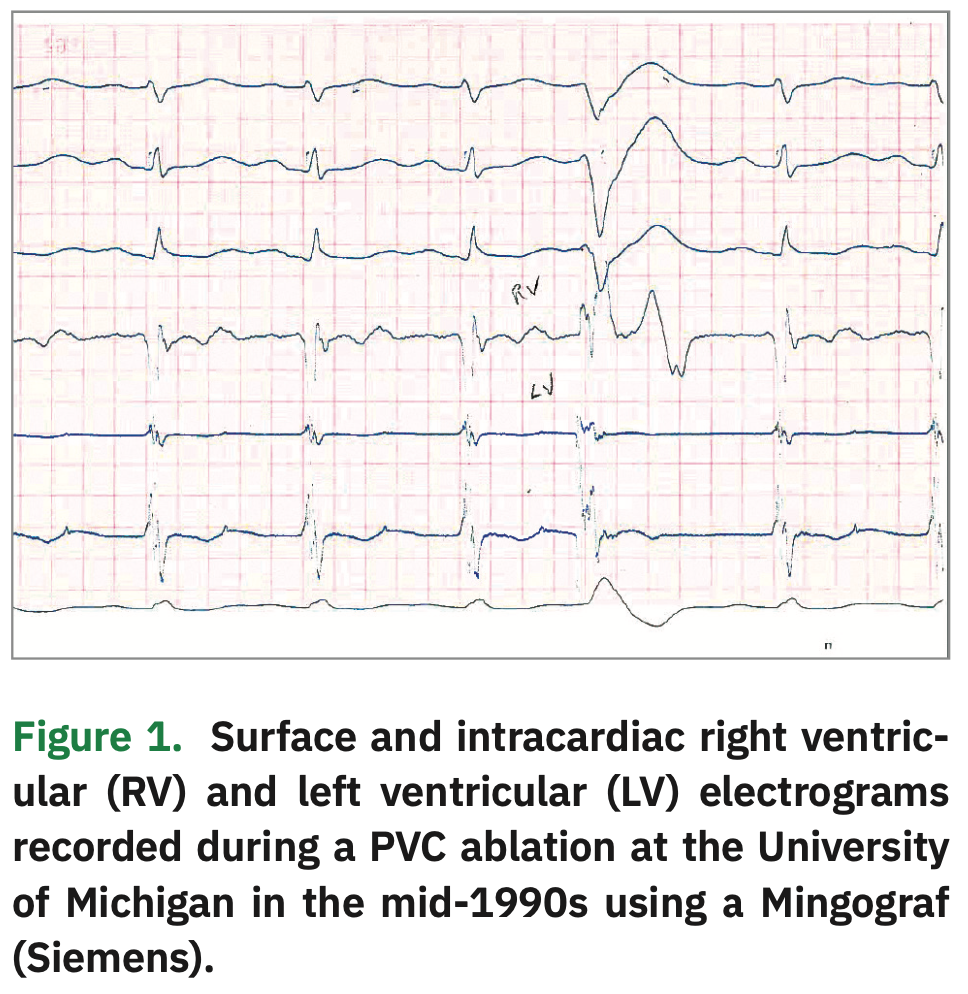ADVERTISEMENT
Further Optimizing Electrogram Signal Quality in the EP Lab
Digital recording systems designed to display and record intracardiac electrograms (EGMs) were introduced into electrophysiology (EP) laboratories in the mid-1990s. Prior to this, EGMs were displayed on a monitor and printed with a stylus directly onto a scrolling roll of paper using a Mingograf (Siemens), affectionately referred to as the “Mingo.” These analog EGM recordings produced high-fidelity intracardiac recordings (Figure 1). Activation times were determined using an old school ruler and pencil. Playing the Mingo was like playing a musical instrument, requiring special skills to abruptly increase and decrease the sweep speed during extrastimulus testing to better capture the key signals. For obvious reasons, these paper systems, which required special paper and ink, were quickly replaced by electronic EP lab recording systems. At that time, a lot of effort went into selecting the commercial system that best displayed the EGM signals without loss of critical high-frequency, low-amplitude signal components.
Nothing replaces a high-quality EGM in the EP lab. Identification of an accessory pathway potential, or a low-amplitude diastolic potential during a reentrant tachycardia, can be the difference between success or failure during a catheter ablation procedure. Improvements in signal processing over the years have resulted in better EP lab recording systems. Advanced 3D mapping systems have further improved signal processing, and now high-density mapping capabilities have dramatically changed our field. However, the EP lab is still a noisy place. Efforts to reduce electrical noise in the EP lab include keeping cables off the ground, avoiding crossing of cables, filtering, and grounding anything electrical in the lab.
Despite all of these improvements, the quality of EGMs is rarely optimal. Problems include loss of critical parts of the signal during the filtering process, an unacceptable signal-to-noise ratio (Figure 2), the inability to see EGMs on the ablation catheter during delivery of radiofrequency current, and saturation of the signals during pacing and defibrillation. Fortunately, there is a renewed interest in improving EGM quality in the EP lab.
Gianni et al recently evaluated a new system, the PURE EP System (PEP; BioSig Technologies, Inc.), a real-time signal processing and display platform designed to address the current limitations of EP lab recording systems. The PURE EP System acquires the full range of cardiac analog signals in a raw, streamlined, unfiltered format, and then converts the signals into a digital modality using proprietary signal processing software. The system is reported to be compatible with existing EP lab equipment. In the study, 3 independent electrophysiologists used a rating system to compare surface and intracardiac EGMs from this novel recording system to the same signals from a standard recording or 3D mapping system. The results were presented during the European Society of Cardiology meeting and published in abstract form.1 Based on the ratings for 34 pairs of signals, 85% of the PEP signals were rated as equivalent or better. In 36% of samples, the reviewers selected PEP because “more signal components were visible.”
It has been a long time since we used a Mingo recording system in the EP lab, but it has also been a long time since any novel techniques have been developed to further improve EGM signal fidelity. Given the critical importance of intracardiac EGMs during most ablation procedures, any new ideas to improve EGM fidelity are welcome.
Stay safe,
Bradley P. Knight, MD, FACC, FHRS
@DrBradleyKnight
Editor-in-Chief, EP Lab Digest
Disclosures: Dr. Knight reports that he is a consultant, speaker, investigator, and offers fellowship support for Abbott, Baylis Medical, Biosense Webster, Inc., BIOTRONIK, Boston Scientific, Medtronic, and SentreHEART. He has received compensation for serving as a consultant to CVRx, Inc. He has also served as a consultant to BioSig Technologies, Inc.
- Gianni C, Al-Ahmad A, Knight B, et al. A novel cardiac signal processing system for electrophysiology procedures: early insights from the pure ep 2.0 study. Eur Heart J. 2020;41(Suppl 2): ehaa946.0390. https://academic.oup.com/eurheartj/article/41/Supplement_2/ehaa946.0390/6002294.













